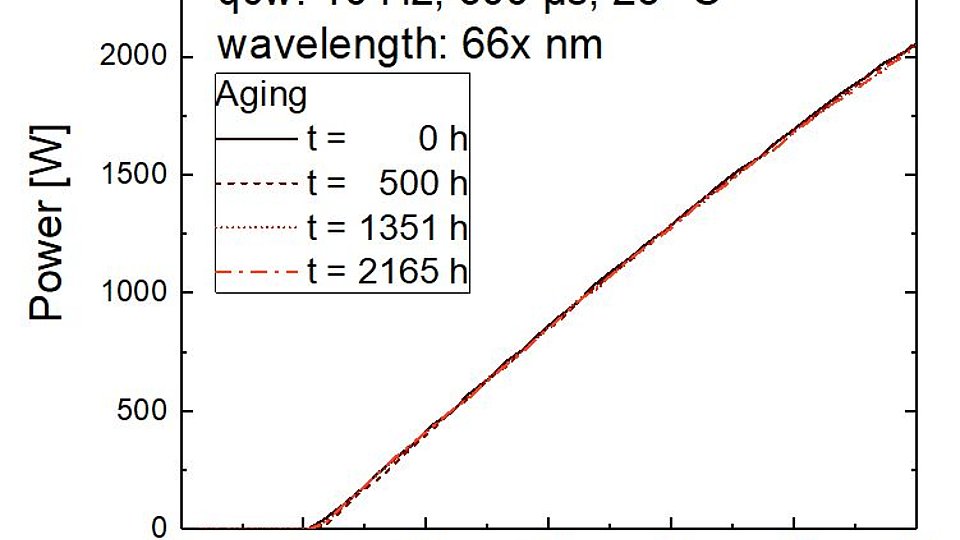High-power-class QCW Red Laser Bars and Stacks for Pump and Direct Application
Fig. 1: Sketch of processed laser bars with 100 µm broad area lasers. Top: 20 emitters on a bar with a fill factor of 20%, middle: 49 emitters on a bar with a fill factor of 49% and bottom: 70 emitters on a bar with a fill factor of 70%.
Fig. 2: Optical power and conversion efficiency per emitter as a function of bias current for an example single emitter and bars with 20 to 70 emitters, lasing close to 680 nm.
Fig. 3: Maximum output power of the mounted bars with 70 emitters (stars) compared with best reported literature values (cw: green squares and qcw: magenta squared). See Ref 1 for reference.
Red diode lasers with emission wavelength in the 630 – 700 nm range with the highest possible reliable powers and efficiencies are needed as light sources for direct and pump applications. Amongst others these include the pumping of alexandrite lasers (chromium doped chrysoberyl lasers) and Li-DPALs (lithium-ion based diode-pumped alkali lasers). Direct applications include medical (photodynamic therapy), cosmetics (tattoo removal) and displays (laser projection).
The production of reliable high- power lasers in the red spectral range is especially challenging due to two characteristics of these lasers. Firstly, due to band gap restrictions in the arsenide and phosphide system the barrier against leakage of electrons from the quantum well is low. Therefore threshold current and efficiency of these lasers are highly temperature sensitive. Secondly, the high photon energy (compared to near infrared semiconductor lasers) leads to a higher load on the facets, which can lead to low operating powers, if the reliability of the output facets is insufficient.
In the past year, FBH researchers have continued their work to improve the power of red diode lasers in collaboration with industry, as recently presented at Photonics West in San Francisco, USA.1
A well-established epitaxial laser structure from the Ferdinand-Braun-Institut was used in combination with the insitute’s proprietary (ZnSe-based) facet passivation technology, a configuration which has demonstrated high reliability of more than 10 000 h.2 The epitaxial structure was investigated for use as 1-cm wide broad-area laser bars (see Fig. 1) and the impact of the bars fill factor on power and efficiency was assessed. In contrast to earlier work, the resonator length was increased from 1.5 mm to 2.0 mm for lower thermal and electrical resistance. Bars were processed with a fill factor (FF) of 20%, 49% and 70% by increasing the number of emitters on a bar from 20 through 49 to 70, with each emitter being 100 µm wide. After facet passivation and coating, the bars were mounted on conductively cooled kA- class QCW packages. Measurements were performed under quasi continuous wave (qcw) conditions (10 Hz, 600 µs) at a temperature of 25 °C.
Optical power per emitter of a reference single emitter and all three fill factors are shown in Fig. 2. There is no significant change in optical power per emitter with increasing fill factor. The slight decrease in the slope can be attributed to heating from neighboring emitters. The maximum optical output power achieved (<350 W) is increased by a factor of 3 compared to literature values for all wavelengths investigated, as seen in Fig. 3. We attribute this increase to the use of long resonator lengths and high fill factors for low resistance, in combination with high quality epitaxy and facets.
Motivated by these results, an 8-bar stack was assembled by Coherent|Dilas from bars of the shortest wavelength (66x nm) and the highest fill factor (70 emitters). An optical power of more than 2 kW (10 Hz, 600 µs, 25 °C) was produced, delivered at a wavelength of 665 nm, ideal for pumping alexandrite crystals. The stack was aged under the same pulse (qcw) conditions for more than 2000 h (>70 million shots) at a current of more than 200 A. No degradation was measured, as confirmed in repeat testing, shown in Fig 4.
Publications
[1] Niemeyer, M., Martin, D., Pohl, J., Weyers, M., Knigge, A., Crump, P., Kissel, H. and Biesenbach, J., “High-power-class QCW Red Laser Bars and Stacks for Pump and Direct Application,” Proc SPIE (2019).
[2] Sumpf, B., Fricke, J., Ressel, P., Zorn, M., Erbert, G. and Tränkle, G., “100,000 h estimated lifetime of 100-μm-stripe width 650 nm broad area lasers at an output power of 1.2 W,” Proc SPIE 8277, 82771I (2012).



